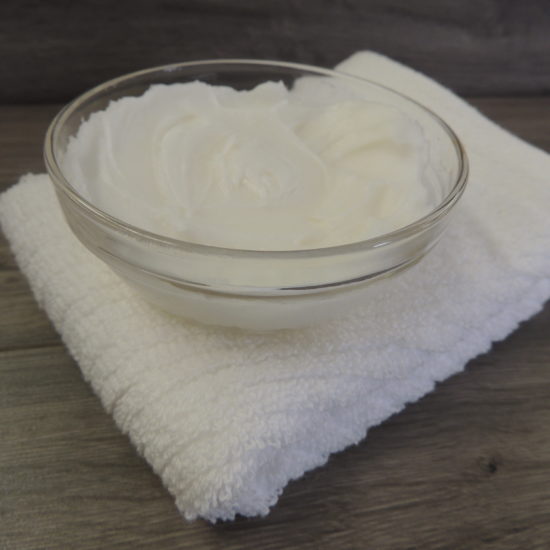
Processed food is food that’s changed in any way from its natural state. That includes washing, canning, freezing, or adding ingredients to it. Baking, cooking, or preparing it counts as processing, too.
For the unfamiliar, being catfished is when someone fakes their persona and leads you to believe they’re someone totally different than who they really are. A swimsuit model who’s also the CEO of her own million-dollar company? More like a 59-year-old man who saves his toenail clippings.
And it turns out that online users aren’t the only culprits of catfishing—so are food manufacturers. That’s right, many of the foods lining supermarket shelves call themselves one thing, but they’re really quite different from what consumers have been led to believe based on their appearance and language used on the packaging.
Thanks to the combination of exploiting labeling technicalities and downright stellar jobs by these products’ marketing teams, we’d like to introduce you to these foods that are less trustworthy than gas-station sushi. (Or your sketchy ex.) Find out if the processed foods you’ve been eating are really what you think they are.
“Maple” Syrup
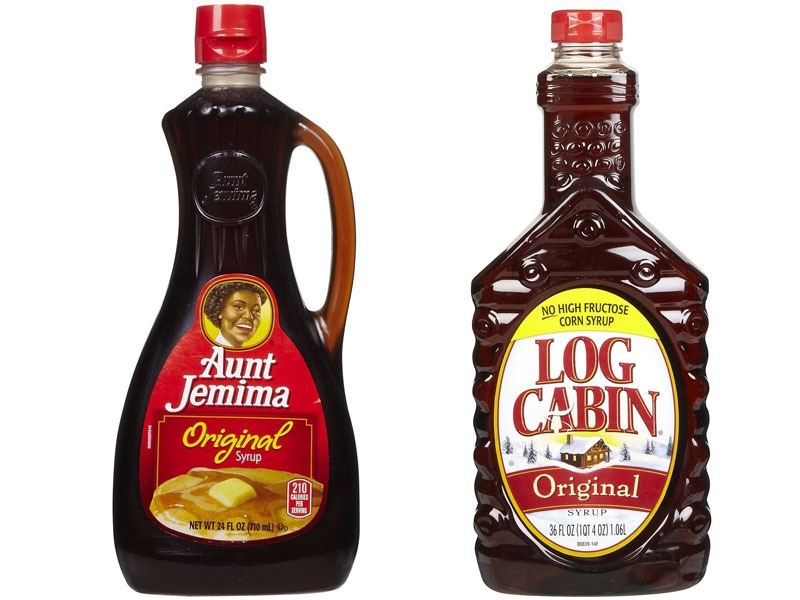
Yes, technically brands like Aunt Jemima, Mrs. Butterworth’s, and, most deceptively, Log Cabin, only call their products “syrup,” but their marketing sure says otherwise. Whether their dark amber color shines through clear plastic bottles or lies hidden within the same plastic jugs that have housed maple syrups for generations, there’s no discrepancy that these companies want you to equate their product with the real stuff, Grade A maple syrup—you know, the sap that’s tapped from maple trees and boiled into an antioxidant-rich sweetener? But unlike this functional sweetener, these syrups are primarily composed of high fructose corn syrup, artificial flavors, and caramel color—all ingredients that have been connected to a slew of health issues, from fatty liver disease to cancer.
White Chocolate

Think of white chocolate like white, refined flour: over processed and devoid of nutrients. White chocolate’s only “chocolate” comes from cocoa butter (the rest is milk solids, milk fat, and sweetener), and even that ingredient commonly loses its antioxidant properties during a “deodorizing” step. Without non-fat cocoa solids, white chocolate doesn’t have any flavanoids—antioxidant compounds that have been shown to improve glucose metabolism and lower blood pressure—or gut-healthy prebiotics, which help reduce inflammation and fight weight gain. It also lacks the ability to stimulate the euphoria-inducing chemicals that real chocolate does, including serotonin. Grabbing some chocolate? The darker the better. More cacao means more happy chemicals and less sugar.
Cool Whip
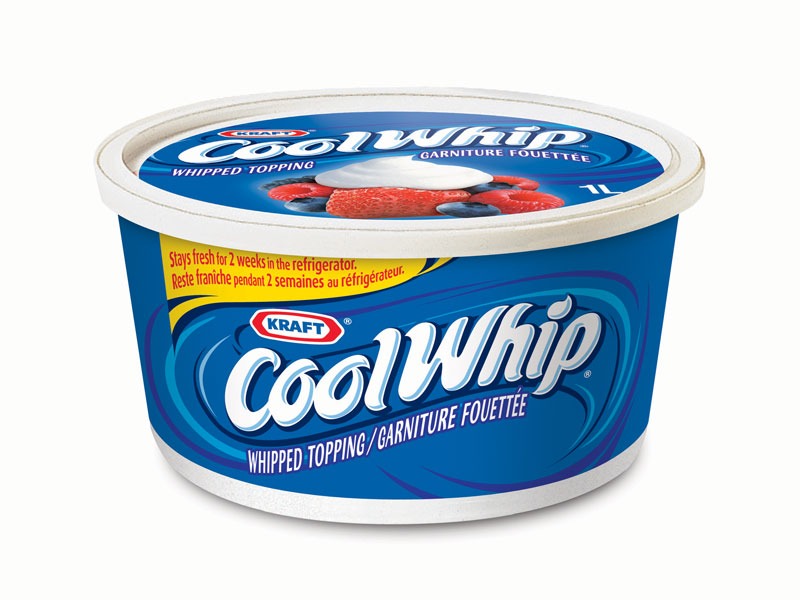
Whip, as in whipped cream, right? Not exactly. Kraft Cool Whip’s first ingredient is water, followed by hydrogenated vegetable oil, high fructose corn syrup, corn syrup, and finally, skim milk. Fun fact, the original recipe was “non-dairy”—it didn’t even have milk! Kraft only started adding skimmed milk and light cream in 2010. And although Kraft is the most common store-bought brand, you should also be checking the ingredients of any generic “whipped” topping out there. Looking for whipped cream? Buy a little carton of heavy cream, grab a mason jar, and start shaking!
Bac’n Bits
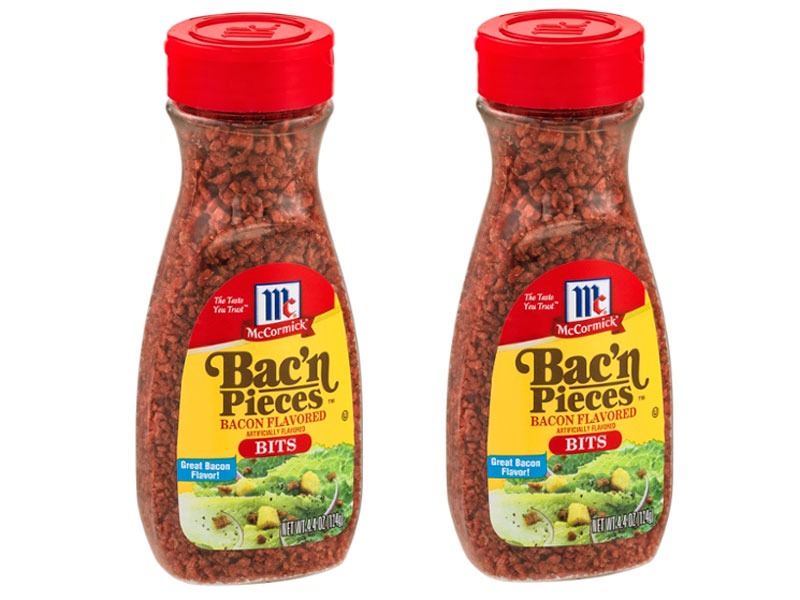
When an apostrophe replaces a letter in a food’s name, it’s a dead giveaway this product isn’t what it wants you to think it is. Oh, and the label’s “bacon flavored.” Textured soy flour and oil provide the “bit,” carcinogen-contaminated Red 40 and caramel coloring provide the visual cue this stuff sure looks like bacon, and the combination of yeast extract, disodium inosinate, and disodium guanylate—otherwise known as MSG—provides the meaty, umami flavor. These so-called “flavor enhancers” have been implicated in increasing appetites along with stimulating your body to pump out insulin, the fat-storage hormone. If you fried up a slice of bacon and crumbled it, you might be eating double the calories, but you’d save yourself 180 mg of sodium.
Kind Blueberry Vanilla & Cashew Bar
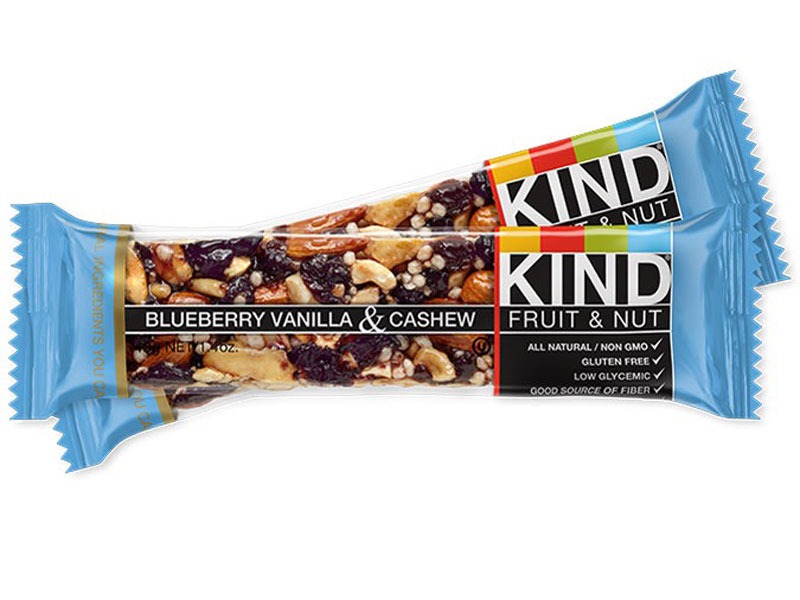
We’re big fans of KIND bars because their products are low in sugar and high in satiating, healthy fats and protein, but they might not be giving you exactly what you think. Yes, even healthy foods can be untrustworthy. This bar boasts the name “blueberry,” but upon a closer look at the ingredients, we see KIND really means apples and plums. Huh? In reality, KIND’s formulation of its “blueberry pieces” is actually “blueberries, sugar, apples, plum, apple juice, vegetable glycerine, citrus pectin, natural blueberry flavor.” Rather than nosh on this bar with “natural blueberry flavor,” pop a few raw blueberries to burn belly fat, boost memory, and uncover your abs.
Dean’s Guacamole Flavored Dip
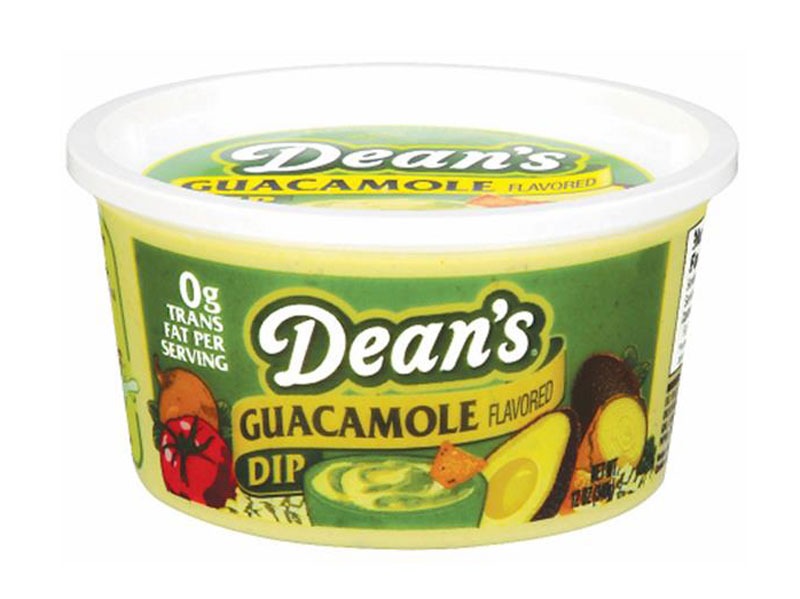
Just because the label says “guacamole” and the stuff inside looks green does not mean this product is bursting with the same fat-blasting properties as avocado. Keep reading and you’ll see one of the most telling words in branding: flavored. This imposter is made mostly of skim milk (!), oil, water, and tomatoes. And less than 2 percent real avocado! With all its liquid, how is this guacamole-style dip dip-able? It’s from emulsifying egg yolks, gelatin, a slew of gums and gels, and then thickening it up with isolated soy protein. And that green color you see? It’s just blue, red, and yellow food dyes. Besides the fact that real avocados will lend their free-radical-fighting benefits, sticking with the green fruit will also help you avoid this waist-widening concoction.
Commercially Grated Parmesan Cheese
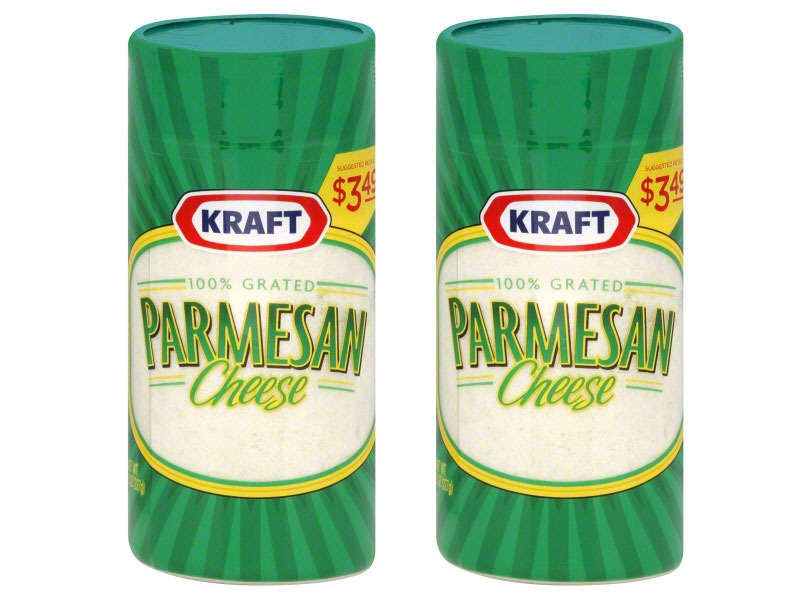
Wood you like some wood pulp on your pasta? No? Well then maybe you should nix the pre-grated parmesan cheese. Kraft was slammed with a lawsuit in early 2016 for using cellulose, an anti-clumping filler made from wood chips, in its “100% Grated Parmesan Cheese” product. And more private testing found Castle Cheese Inc.’s “Parmesan” also included less expensive cheese like cheddar, swiss, and mozzarella. In fact, American versions of Parmesan cheeses are so far from the real thing (they also include nontraditional ingredients such as potassium sorbate and cheese cultures) that the European Union wanted to ban American-made cheeses from even calling their product parmesan! A little advice? Buy a grater and grate it yourself.
Sunny D
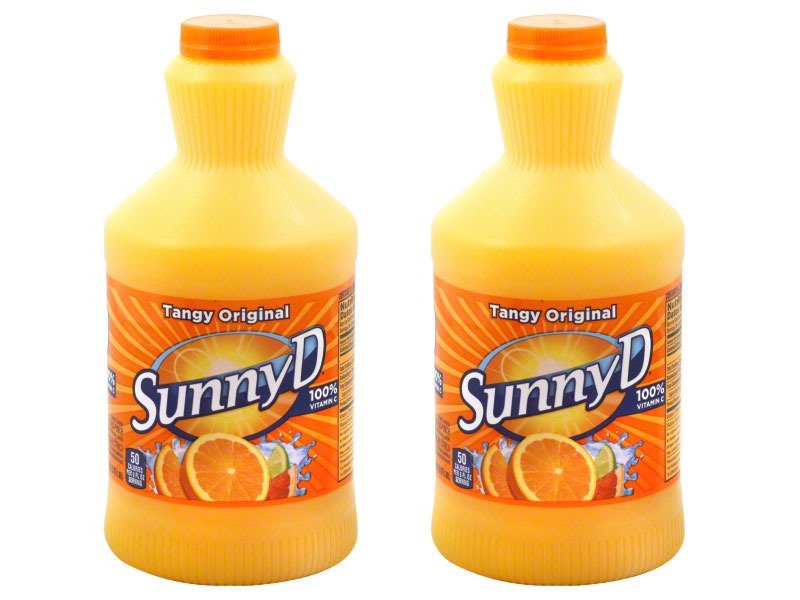
If the sun tastes like corn syrup, modified cornstarch, canola oil, cellulose gum, artificial sweeteners, artificial flavors, artificial colors, and loads of preservatives, Sunny D certainly unleashed it. And while Sunny D Tangy Original promotes that it has 100 percent of your vitamin C for the day, the majority (a whopping 98 percent) of this drink is just water and high fructose corn syrup. That’s right. That orange you see on the label is only present in the “2% or Less” section, along with five other fruit concentrates, so that amount of vitamin C is probably only coming from the added ascorbic acid. If you want some orange juice, you’re better off going with something that has to be refrigerated, like Evolution Fresh’s Cold-Pressed Orange Juice.
Fruit Snacks
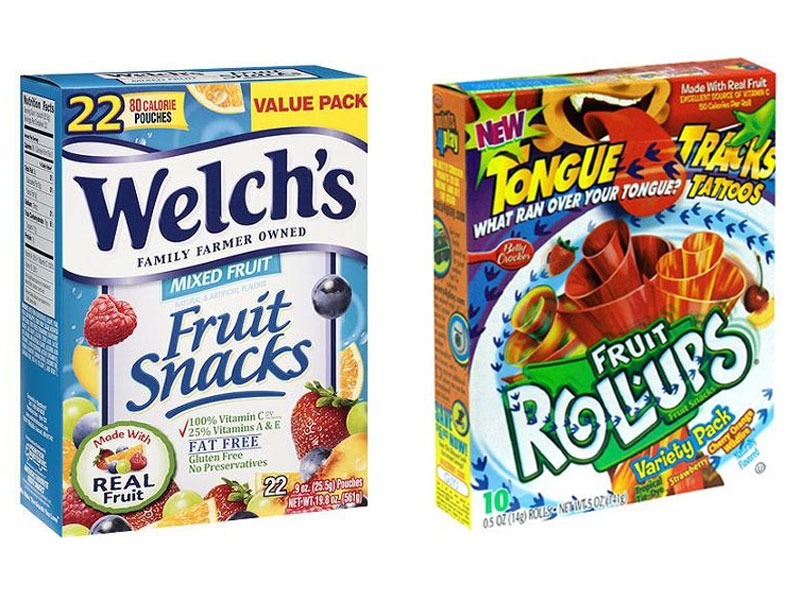
Yes, the first ingredient is usually fruit and vegetable juice blend from concentrate, but following that is sugar, corn syrup, and modified corn starch, along with more sugar, and carnauba wax. Heck, some roll-ups even include partially hydrogenated oils—aka artery-clogging trans fats now banned by the FDA! And don’t be fooled into thinking these gummies are as healthy as the real thing just because they have the word “fruit” in them. In fact, fruit juice is one of the worst added sweeteners for your health because it’s high in liver-wrecking fructose and low in the slow-digesting fibers that make fruit healthy in the first place. Snack on real fruit to get the fiber and nutrients that come naturally packaged with it.
Just Mayo
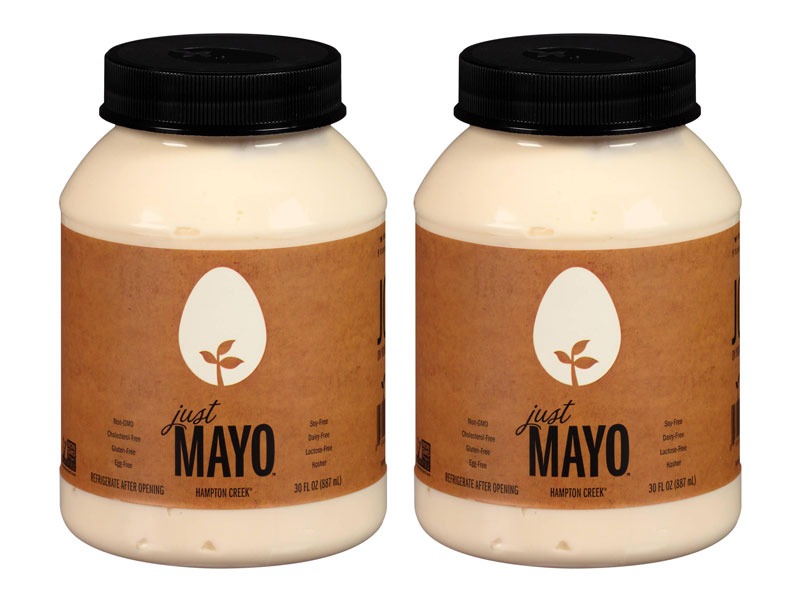
While this might be the only product on the list we wouldn’t dock for its ingredient list, it has rightfully earned its place as an untrustworthy food. That’s because Just Mayo isn’t actually just mayo. According to the FDA’s “Standards of Identity,” the condiment has to have vinegar, lemon juice, and an egg-yolk-containing ingredient in order to be called mayo, and because Just Mayo is vegan, it has no eggs. (Which is weird because the label also has an egg on it.) Maybe “I Can’t Believe It’s Not Mayo” would be a better name. If you’re as confused as we are, but still want a vegan mayo, check out Sir Kensington’s new Fabanaise, a mayonnaise-like spread made with chickpea water!
Whole Wheat Breads
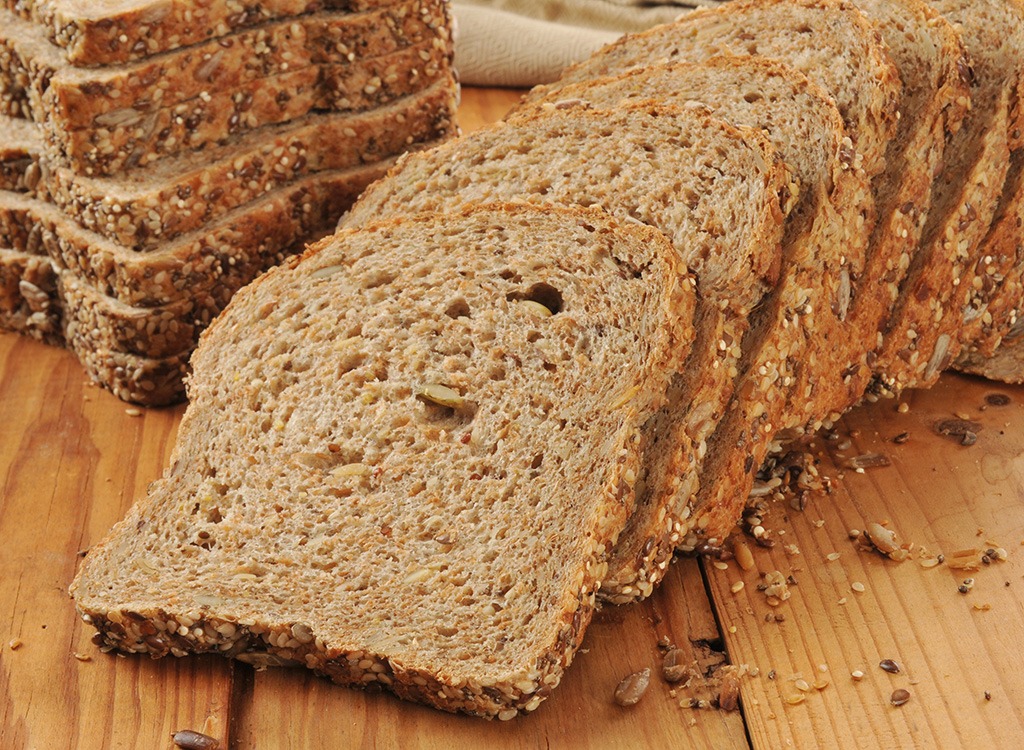
You’ve been told to eat more whole grains, but don’t think that choosing whole wheat ensures a healthy pick. According to a Harvard School of Public Health study, many products displaying the yellow Whole Grain Stamp have more sugar and calories than whole grain foods not bearing the logo. That’s because manufacturers realize that many of us still crave the sweetness of white breads, so they add back the sugar to make whole wheat taste better. When you’re looking for a whole grain bread, make sure whole wheat is listed as the first ingredient and the food should ideally be free of high fructose corn syrup.
Processed Cheese
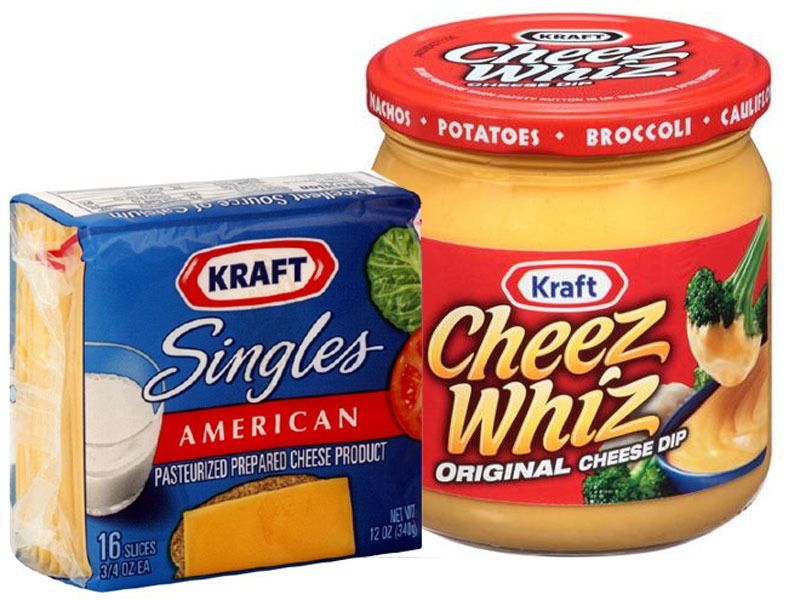
Whiz or whizout? That’s the question you’ll often be asked in reference to whether you’d like your Philly Cheesesteak doused with a heaping spoonful of Cheez Whiz. Or should they be called a cheezsteak? That’s because Cheez Whiz, along with processed cheese products like American Cheese and Velveeta aren’t really cheese at all. In fact, federal laws mandate that each of these products be labeled as “processed cheese” or a “cheese product” since their manufacturing process is quite different from natural cheeses: they start with only 51 percent real cheese, add some artificial flavors, colors, fillers, preservatives, emulsifiers, acidifiers, heat it up, and then wrap it up. Reach for a block of 100 percent real cheddar—the U.S. just imported way more than we need, so cheese prices are about to go way down.
Southwestern Egg Beaters
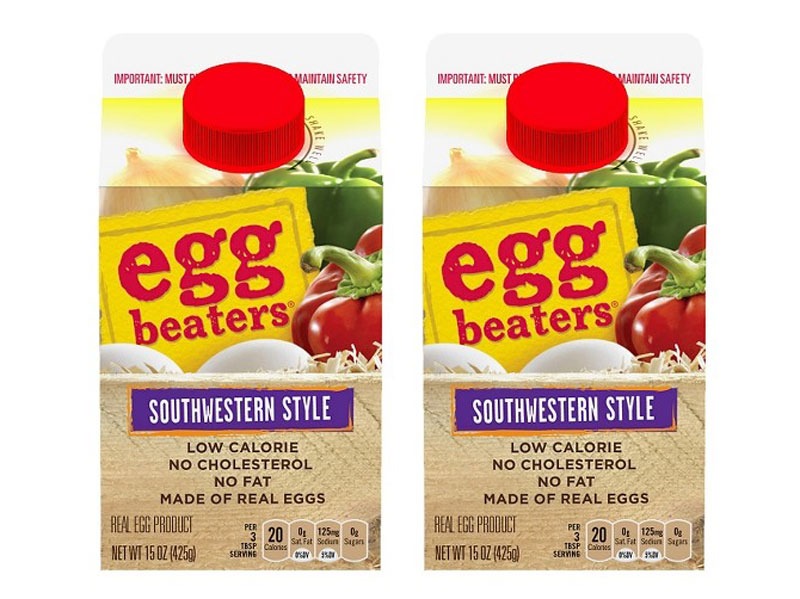
We’ve already busted the egg-yolk myth, but if you’re looking to boost your protein intake, we can see why you might want to pick up a carton of egg whites. But don’t think all you’re getting in a carton of Southwestern Egg Beaters are eggs. Somewhere between processing and packaging this carton also picked up a few extra ingredients, like “natural flavors,” a slew of gums, autolyzed yeast extract (aka MSG), and a tinge of color to make it feel like you’re eating the real thing. You know what’s better than feeling like you’re eating the real thing? Eating the real thing: Whisk two eggs together (yolks and all), season with salt and pepper, and dice up a red pepper. Saute the pepper in light canola oil for about a minute, or until it’s tender, pour in the whisked eggs, and cook until done. Voila! And no “autolyzed yeast extract.”
Reduced Fat Peanut Butter
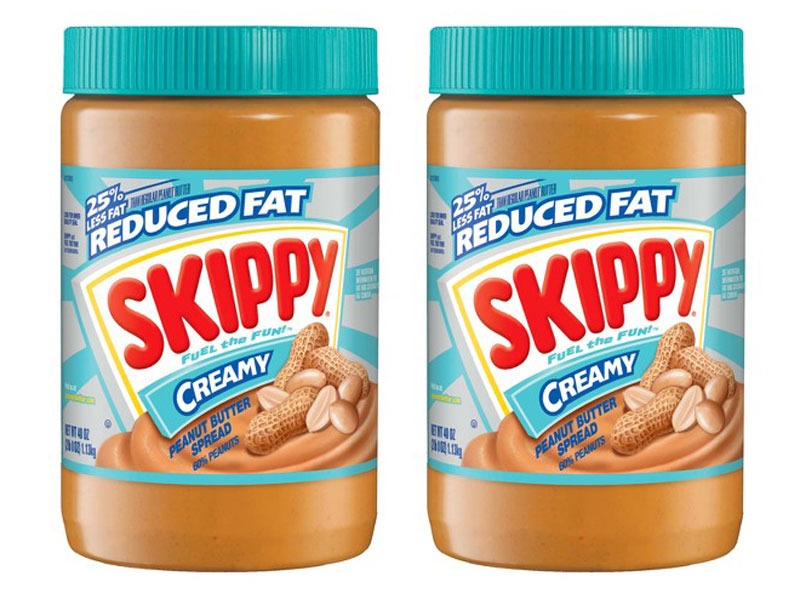
Peanut butter is touted by experts as a health food—packed with protein, fiber and healthy monounsaturated fats, plus plenty of fat-burning folate. But when you pick up a reduced fat butter, you’re getting a product that’s packed with sugar and fillers, causing you to store fat, not burn it. When manufacturers take out the naturally-occurring, healthy fat, they’re left with a bland product in need of some serious doctoring up. So they add things like sugar, corn syrup solids, and soy protein concentrate. And regardless of whether you go for fat or not, picking Skippy means your PB will contain hydrogenated vegetable oil, the trans fat which researchers found to increase heart disease risk by a whopping 23 percent. The best butters have just two ingredients: peanuts and salt.
Agave Syrup

People ate up the fact that Agave syrup was a great alternative to sugar because it was natural and came from a plant. Newsflash! Sugar also comes from a plant—so you can throw out that argument. Plus, agave is actually a modified sugar, which means you can’t actually tap an agave plant and get syrup. The syrup has to be processed (yes, it’s technically a processed food) with enzymes that turn it into sugar. Another argument by marketers? It has a low glycemic index, which means it doesn’t spike blood sugar levels right after eating it. And that’s actually a bad thing. It has a low GI because it’s full of fructose—at least 80-90 percent, way more than the 50 percent of white sugar—a form of sugar that doesn’t affect glucose levels, but it can lead to insulin resistance, fatty liver disease, hypercholesterolemia, and obesity over time.
Frozen Banquet Burgers
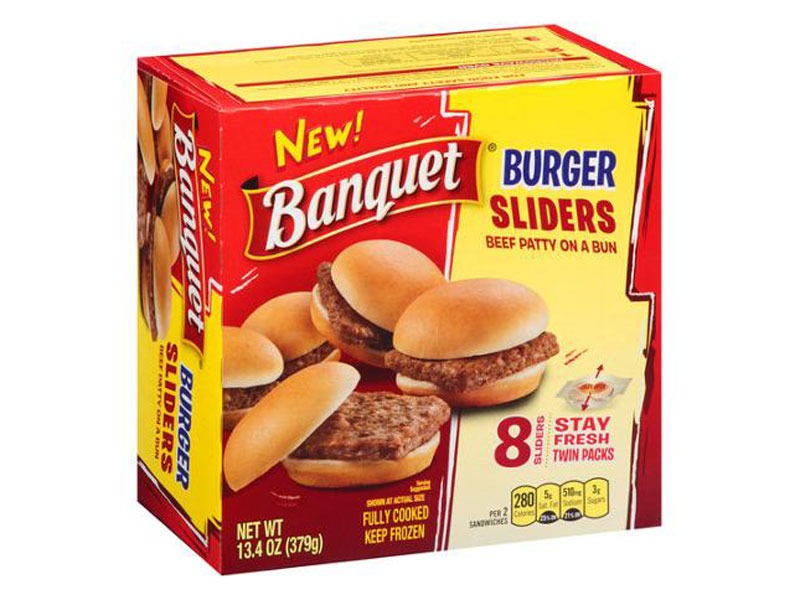
They might be convenient, but these sliders are certainly a stretch of the truth. In reality, they’re closer to veggie burgers than they are beef burgers. That’s because Banquet’s patties are made of beef, water, textured soy protein, soy flour, caramel color, soy protein concentrate, and soy lecithin. You’re better off whipping up your own burger at home using 100 percent grass-fed ground beef. It’ll probably take more time to preheat the oven for these nasty sliders than it will to simply sear your perfect patty in a skillet.
Potato Snacks
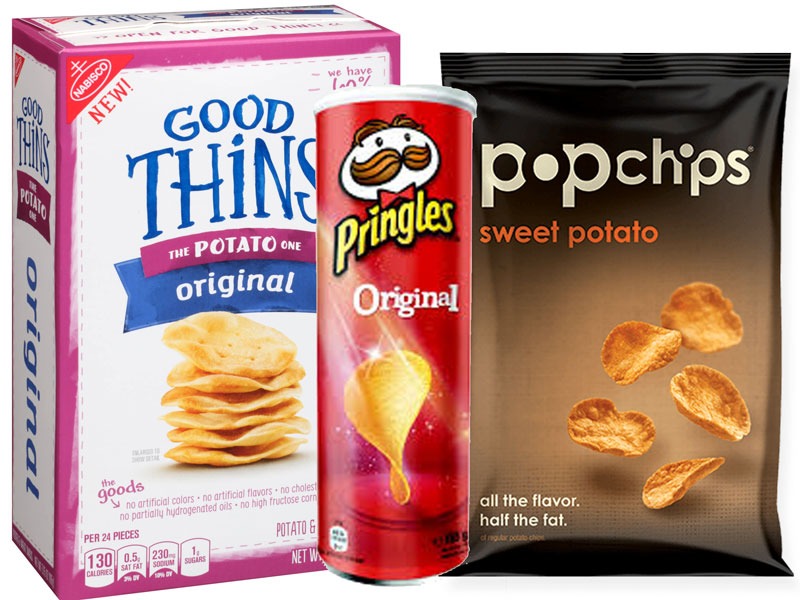
Whatever the brand, these potato chips aren’t what you imagine when we say “Lay’s.” Rather than sliced potatoes, these “chips” are really pulverized potato flour mixed with varying additives like oils, fibers, and yeast extracts and then molded into a chip-shaped snack. What’s even more amusing is that the Kellogg Company actually argued with the U.K. government that Pringles weren’t chips so that the product wouldn’t be taxed as a luxury item. And a judge agreed, citing the fact they were unnaturally shaped and were made up of less than 50 percent potato. Congrats?
Hot Cocoa Mixes
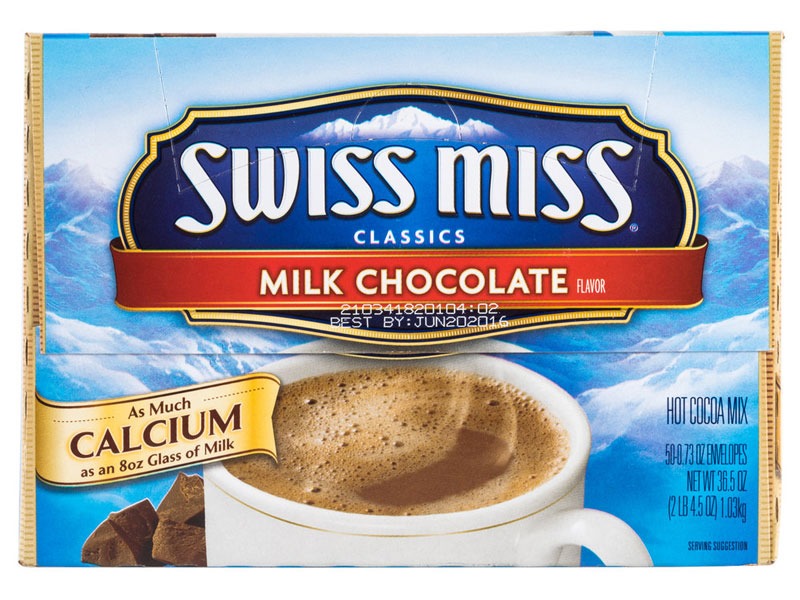
With everyone touting the health benefits of chocolate, it’s no wonder our go-to warm-me-up drink during the cold months is chocolate. But just because cocoa is on the label doesn’t mean this product is healthy. Many hot chocolate mixes should really be called “Sugar Blends with Oil, Additives, and Oh yeah, Some Cocoa.” Cocoa is actually listed fourth on Swiss Mix’s list of ingredients, and what’s worse is that the cocoa powder is alkalized, meaning it’s devoid of any healthy antioxidants. Make your own hot chocolate but just boiling a cup of whole milk mixed with a tablespoon of pure cacao—the naturally-occurring sugars in the milk are all you need to sweeten this beverage up.
Coffee Creamers
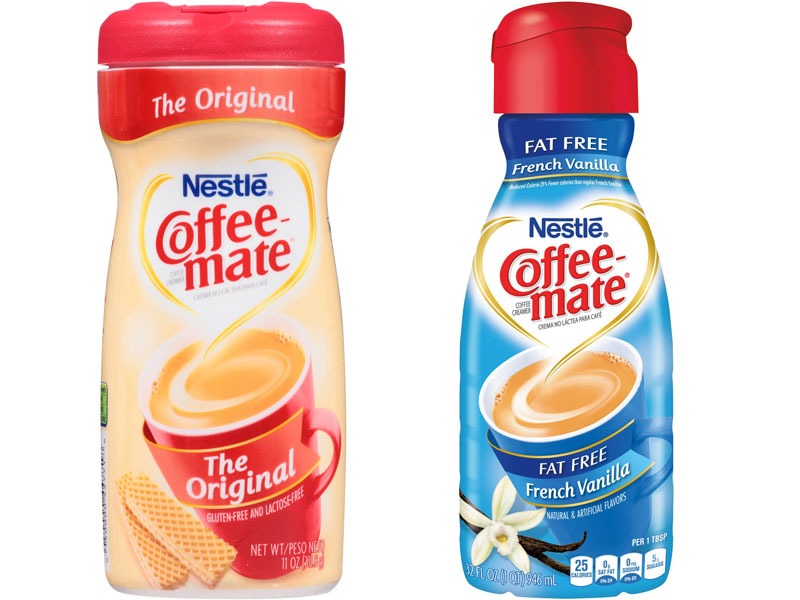
We don’t know about you, but when we read the word “creamer,” dairy cows come to mind. Unfortunately, that’s not what you’re getting when you pick up coffee creamers like Coffee-Mate. In fact, the brand even labels it as lactose-free! And in true untrustworthy food fashion, this creamer is none other than corn syrup solids and hydrogenated vegetable oil in disguise. But hey, there is milk protein! That counts, right? Wrong. If you’re looking for something to add to your coffee, add heavy cream.
20
“Low Carb” Bars with Added Fiber
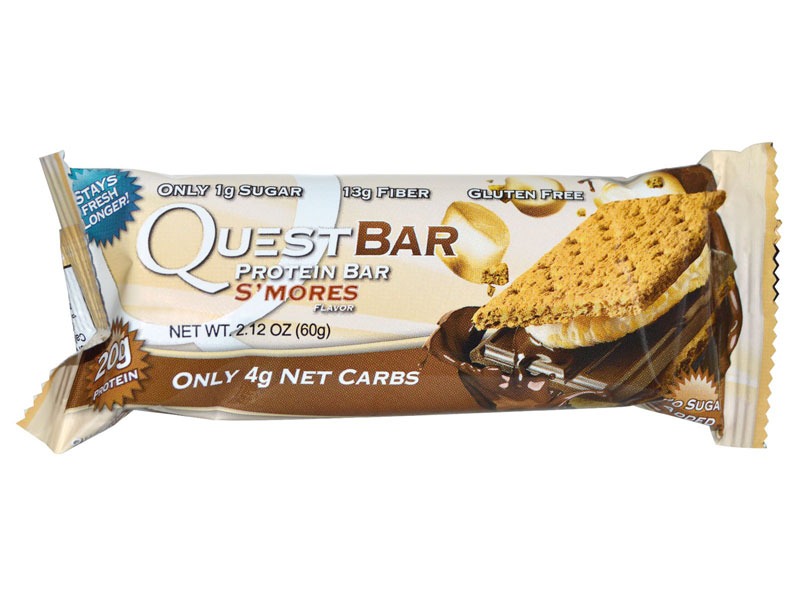
Ever heard of net carbs? Many diets are based on this term, claiming that we should only be worried about the total carbs minus the amount of fiber because fiber is what helps slow digestion of the carb sugars, keeping blood sugar from spiking and hunger at bay. We’d be on board if it weren’t for the fact that many companies lower the net carb count by adding functional fibers to their bars and meals. Functional fibers, like polydextrose, are synthetically created in a lab, and may not provide all of the same benefits that the dietary fibers from veggies, whole grains, and fruits do. According to multiple studies, polydextrose is fermented like fiber and has beneficial effects on bowel function, but a study in Nutrition Review found it has little or no effect on fasting glucose levels and doesn’t form the same kind of filling viscous gel that dietary fibers do to slow the rate at which food is broken down and nutrients such as glucose are absorbed—which means it might not actually help keep you fuller longer.
This article first appeared here.



















